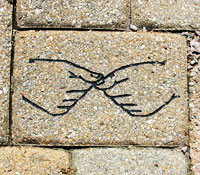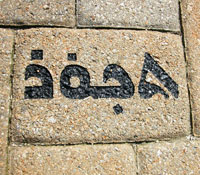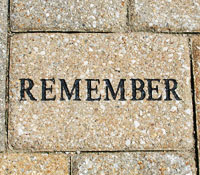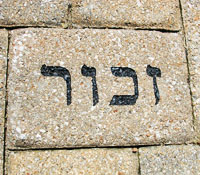Promise for life
History of "Promise for Life" Sculpture
Following a moving class presentation by Alfred Tibor, a Holocaust survivor and sculptor, then President Dennis Anderson (1990-2000) invited him to his office for a personal conversation. Dr. Anderson asked Mr. Tibor to produce a sketch for a public sculpture that would be placed in a prominent position on the Trinity campus. The president gave Mr. Tibor a theme that proclaims how God confronts and deals with our sin and our hope for life:
“Out of the flames of human hate come the ashes of death. Out of the flame of God’s love comes the promise for life.”
This theme is engraved on the base of the completed Sculpture.
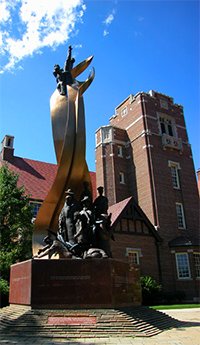
Within several weeks, Mr. Tibor returned with a sketch of a dramatic bronze flame rising through and above a huddled group of men, women, and children surrounded by barbed wire. At the top of the flame stand a mother and father lifting up their newborn child. Moved by the sketch, President Anderson requested that Mr. Tibor develop a model, which was then displayed for the community. Discussions with the Trinity faculty and Board of Directors led to the approval and establishment of an inter-faith committee to further develop the concept and raise funds for the sculpture. The Promise for Life Committee included representatives of the Jewish, Roman Catholic, Baptist, Lutheran and Methodist communities and Trinity Lutheran Seminary. The formal phase of fund raising began in January 1997. They eventually raised more than $200,000 to fund the sculpture and the surrounding landscape.
Early in the project, those involved requested it be a “living” sculpture. They wanted it to be more than a monument; it must be a stimulus and inspiration for interfaith dialogue. A task force was formed to explore and develop public events for Jewish-Christian dialog. Later, the task force determined that the dialogue should extend beyond Jewish-Christian to include other faith traditions.
The sculpture and garden were dedicated in an interfaith ceremony on May 23, 1999. This was Pentecost Day in the Christian tradition, which symbolizes the gathering of people of many lands and languages and the outpouring of God’s Spirit-giving unity and life. In addition to President Dennis Anderson, Ann Russell and Ward Cornett III and the entire Trinity Community gave support and leadership to Promise for Life. A host of people provided financial support. Under the leadership of Pastor Cornett, who previously served as Trinity’s liaison to the Jewish community, Promise for Life has proven to be a “living sculpture” providing continuing inspiration for interfaith dialogue and understanding.
About the Sculpture
With its granite base, the bronze sculpture of rising flames reaches a height of 27 feet. The Columbus firm of Allied Fabricating and Welding fashioned the flames from 3/16-inch sheets of solid silicone bronze. Combined with the life-sized bronze figures, cast by Southern Ohio Bronze, the sculpture weighs more than 6,000 pounds. Peter Krajnak, of Feinknopf Macioce Schappa Architects, coordinated a team of contractors and consultants in the creation of an appropriate, dignified environment for Promise for Life. Framed by a backdrop of the seminary’s 1923 brick structures, the sculpture has become a landmark on the corner of the campus. The Jewish Community Center became deeply involved in the project, and eventually College Avenue, which connects Trinity Lutheran Seminary, the Jewish Community Center, and Jewish Historical Society, would be named “Remembrance Way” with the approval of the Bexley City Council.
About the Artist
Many people in Columbus – and throughout the country – have come to know and love the work of artist Alfred Tibor. His sculpture, Hope, is placed at the entry to the James Cancer Clinic in Columbus. Freedom, a gift to the city, is displayed in Battelle Park, and To Life is featured in the Governor’s mansion. Other works are displayed in Indianapolis, Indiana; Clearwater, Florida, and Youngstown, Ohio.
Mr. Tibor and his wife, both survivors of the Holocaust, have dedicated their lives to the establishment of remembrance works, which, while reminding us of the evil power of racial and ethnic hatred, powerfully proclaim the vision of life and hope for all humankind. “Although I survived my imprisonment by hating, once I was freed I knew I would have to give up hating,” says Mr. Tibor. “I want coming generations to understand the concept of brotherhood and give up hate and destruction. We must honor and love each other.”
"Remember" Bricks
The Promise for Life plaza is paved with more than 100 bricks engraved with the word “Remember” in the languages of the world, including sign language and braille—a testament to suffering around the world and the hope for peace and justice. Remember the Holocaust that it never happens again to any peoples anywhere. Individuals, families, and organizations donated $100 for each brick sponsored. This ongoing project helps to fund the sculpture, its upkeep, and the continuing series of events centered on Promise for Life.
